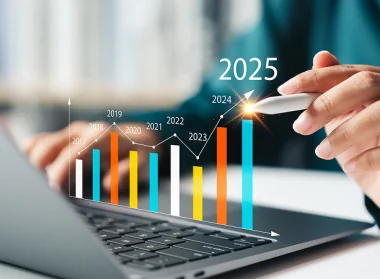While commerce has boiled down to “buy and sell” since the concept was born, the art of doing business effectively continues to evolve over time.
In the modern global economy—fast-paced, data-driven, and increasingly complex—procurement organizations are quickly becoming a primary driver of not just cost savings, but strategic value.
The “buy” half of the commerce equation has become, with help from automation, analytics, metrics, and other emerging technologies, a core component of successful digital transformation.
In order to reap the benefits of true digital transformation, however, companies need to understand the procurement maturity model and apply it effectively in evaluating their current procurement processes.
By understanding how their procurement organization impacts the enterprise as a whole, they can improve their procurement strategies, set and reach goals for higher levels of maturity, and achieve the procurement transformation that is essential to true digital transformation.
What is the Procurement Maturity Model?
While it would be nice (and certainly more convenient) for companies to implement fully mature procurement organizations that spring forth like Athena from the forehead of Zeus, in practice every company has its own unique procurement situation and capabilities.
Well-established, brick-and-mortar companies with a long history of manual workflows and prioritizing cost savings will have a different starting point on the road to full procurement maturity than a fully virtual start-up run by digital natives, for example.
Regardless of their current procurement functionality and capabilities, however, procurement organizations can achieve truly strategic procurement and spend management that drive both value and innovation for their companies through self-assessment and careful optimization of their procurement processes.
The procurement maturity model is used to help companies set and reach goals for optimizing business processes in their procurement function and implementing both procurement transformation and enterprise-wide digital transformation supported by it.
Achieving procurement maturity begins with a procurement capabilities assessment, also called a procurement maturity assessment.
This stage is effectively needs analysis, wherein procurement professionals use assessment tools and methodologies to determine:
- The organization’s current practices and controls for the Procure-to-Pay process.
- The ways in which the organization’s procurement processes affect its capabilities in generating cost savings, value, and strategic insights for the enterprise.
- New goals the organization sets for moving procurement into a more mature and strategically valuable role by improving its capabilities in key areas.
- The tools, techniques, and training required to help the procurement function, and the enterprise, achieve these goals.
The procurement maturity model starts with traditional (tactical) procurement and evolves toward best-in-class (also called world-class) procurement capabilities.
It provides a clear overview of the ways procurement professionals can deliver more value to their organizations over time by improving the procurement department’s functionality and efficiency in key areas.
Incorporated into the procurement maturity model is the procurement capability maturity model, which specifies the capabilities characteristic of, and required to achieve, each stage of procurement maturity. As procurement capability increases, so too does procurement maturity.
The stages of the model are:
1. Tactical and Operational Procurement
Procurement organizations at this stage are still reactive, rather than proactive. They’re focused on cutting costs, securing goods and services at the lowest possible price at the time of purchase, and making sure invoices get paid accurately and on time.
At this level, procurement may not even be a dedicated function, but rather an ad hoc procedure. Staff source and purchase their own goods and services, with Finance (accounts payable) burdened with trying to keep these purchases within budgetary limits while simultaneously paying invoices and tracking spend as best they can.
These organizations don’t have full visibility into, or control over, their spend.
Software solutions that help teams with contract management, inventory management, Procure-to-Pay (P2P) optimization, or spend management are totally absent. Analytics, if present, are provided by the company’s enterprise resource solution (ERP) and focused on expense accounts in the general ledger.
Tactical procurement helps minimize costs in the short term but doesn’t provide the tools, controls, or infrastructure required to generate value, provide insights, or reduce risk for an organization.
World-class procurement teams have full control over the Big Data flowing through their organizations, and by analyzing data streaming from a wide variety of internal and external sources, provide rich, detailed insights that guide decision-making on multiple fronts.
2. Strategic Sourcing Procurement
Companies at this level of procurement maturity are beginning the journey to generating substantial value through business spend management.
They employ dedicated procurement professionals to develop and implement policies and controls for core procurement processes such as purchasing, contract management and negotiation, and the strategic sourcing process.
These organizations leverage the power of strategic sourcing, engaging in much more proactive supplier management.
They use sourcing events to take advantage of optimal pricing through economies of scale and negotiated terms.
They approach supply chain management with an eye toward both savings and value, and implement procurement strategies that help protect business continuity and competitiveness through supply chain resilience.
Procurement departments at this stage recognize the importance of collaborating with finance to streamline and optimize the Procure-to-Pay process.
They invest in software solutions that include automation and analysis tools to develop and enforce spend management policies.
They set benchmarks for, and use key performance indicators (KPIs) to analyze, vendor performance and compliance.
And through the use of artificial intelligence, process automation, and centralized data management, obtain full control over and visibility into their spend.
These organizations generate value for their companies through:
- Long-term savings from more effective contract management.
- Improved operational efficiency across the P2P process.
- Better risk management through tighter controls and the elimination of rogue spend and invoice fraud.
- Better spend control through guided buying.
- Improved supplier relationship management and more effective sourcing processes.
3. Strategic Category Management Procurement
At this stage, organizations are ready to build on the success and value created through strategic sourcing.
They want to expand their capabilities to include advanced category management, as well as more advanced data analytics and modeling.
The procurement department expands to include dedicated category specialists.
These procurement professionals focus all their skills and time on specific spend categories in order to secure maximum return on investment and develop strong, strategic supplier relationships that build value through not just reduced costs, but new opportunities for shared success and innovation (e.g., developing new products sourced with more sustainable materials, strategic partnerships in manufacturing, etc.).
These companies rely on robust, centralized software solutions that include advanced analytics and robotic process automation to manage spend, create accurate and complete forecasts and budgets, and deliver actionable insights senior management can use to make more strategic decisions.
The datasphere is fully integrated, and standardization and automation eliminate data silos to promote better collaboration and communication between stakeholders.
Beginning at this stage, organizations can take advantage of a project management model known as RACI (Responsible, Accountable, Consulted, Informed) to obtain the best possible results from category, supplier, and spend management.
The RACI system helps teams evaluate opportunities and obtain optimal results through careful assessment and analysis of available data, and is best executed with support from software tools.
At this level, procurement organizations have advanced supplier management capabilities and a focus on building supply chains that are both resilient and agile, with the flexibility to capture value from unexpected opportunities and the strength to weather business disruptions.
They use their know-how to advise leadership within the company, guiding their organizations to greater competitive strength and profitability.
4. World-Class or Best-in-Class Procurement
A trusted partner and highly valued source of strategic value and innovation, procurement organizations at this stage have fully aligned procurement’s goals with the company’s and provide the data and insights that fuel enterprise-level initiatives.
Procurement transformation directly powers enterprise-wide digital transformation at this level, and the chief procurement officer (CPO) is a powerful source of strategic leadership.
Continuous improvement through iterative process optimization makes procurement a source of ever-growing savings and value.
World-class procurement teams have full control over the Big Data flowing through their organizations, and by analyzing data streaming from a wide variety of internal and external sources, provide rich, detailed insights that guide decision-making throughout the value chain.
Procurement strategy is tightly aligned with organizational planning at this stage.
Category management and supplier relationship management are collaborative and proactive, enabling the company to seize opportunities to negotiate optimal terms, develop new products to meet changing consumer demand while keeping costs low, and target new areas for growth with confidence.
The datasphere integration achieved at the Category Management level has been further enhanced. A single platform provides control over all areas of procurement and spend management.
Historical spend data, diverse data sources from multiple locations, and financial models are used to set goals and benchmarks, evaluate performance and compliance, and reduce risk. Return on investment is viewed through the lens of total cost of ownership.
Improving Your Procurement Maturity
Understanding where you are, where you need to go, and what you need to do to get there is just the beginning.
But whether you’re just starting your procurement maturity journey or looking to level up, you can enhance your procurement maturity by following a few simple best practices.
Craft Your Procurement Strategy Based on Your Actual Needs and Capabilities
Having performed a procurement maturity analysis and finding you’re a bit behind the curve, it might be tempting to go full-throttle in an attempt to keep up with the Joneses.
But long-term digital transformation success depends on strategic change management. Changing too much, too quickly can not only tax your budget, but create costly chaos that can hamper, rather than help, your procurement transformation plans.
Carefully consider not just the competition, but your company culture, budget, and long-term goals for growth. Starting with the areas most in need of optimization (e.g., the Procure-to-Pay process) can provide a solid foundation of value and savings you can build on over time.
Simply centralizing data management and incorporating process automation can provide the perfect launchpad for more ambitious efforts down the road, and allow you the breathing room you need to establish new protocols and policies and secure buy-in and compliance from everyone in your organization.
Don’t Be Afraid to Invest in Best-in-Class Technology
While it’s crucial to let your budget and capabilities guide your procurement strategy, making the decision to invest in a top-shelf, centralized P2P solution such as PLANERGY as soon as is reasonably possible is a smart way to ensure the long-term success of your procurement and digital transformation initiatives.
Think of it this way: procurement maturity relies on generating value and innovation in the long term.
Shifting procurement to do so requires high-quality, reliable, and transparent spend data.
A centralized, cloud-based software solution that streamlines your business processes, standardizes and secures information exchange, and provides full control over your spend data is key to turning data into decisions.
Transform Your Business with True Procurement Maturity
The journey to procurement maturity takes time, skill, and dedication.
Take the time to perform a procurement maturity assessment, then create the procurement strategy that best fits your goals for helping the procurement team become a trusted and invaluable source of value for your business.
By optimizing your procurement processes and implementing the tools, controls, and policies you need to succeed, you can transform your procurement department into a powerful engine for value, innovation, and digital transformation throughout your organization.




